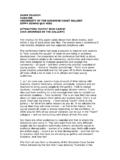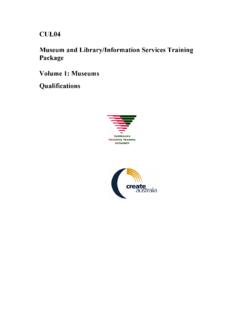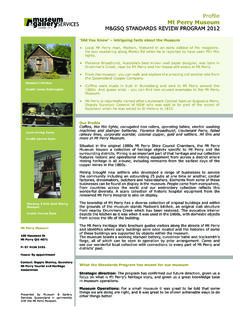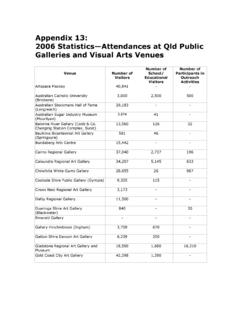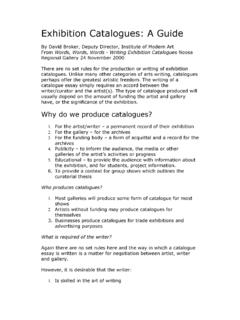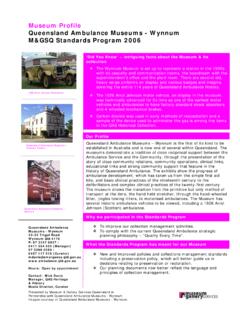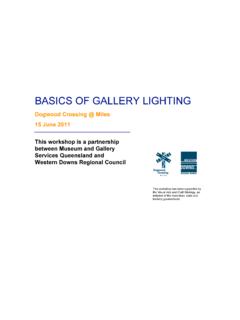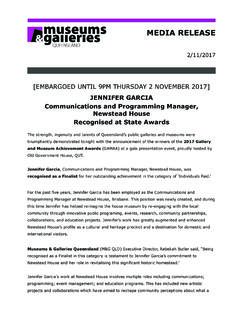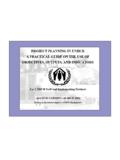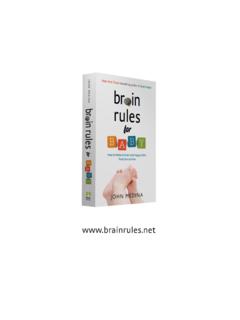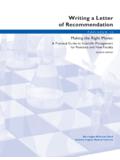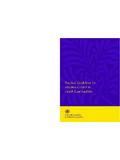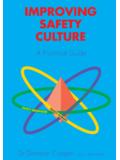Transcription of 13785 A Practical Guide for Sustainable Climate Control ...
1 A Practical Guide for Sustainable Climate Control and Lighting in Museums and Galleries This Project is delivered by Museums & Galleries Queensland in partnership with Museums & Galleries of NSW, Regional and Public Galleries Association of NSW and Regional Galleries Association of Queensland. Museums & Galleries Queensland is supported by the Queensland Government through Arts Queensland, part of the Department of Science, Information Technology, Innovation and the Arts and is assisted by the Australian Government through the Australia Council, its arts funding and advisory body. Museums & Galleries of NSW is supported by the NSW Government through Arts NSW. This Activity received funding from the Australian Government as a part of the Energy Efficiency Information Grants Program and is supported by the Visual Arts and Craft Strategy, an initiative of the Australian state and territory governments.
2 Page 2 / 60. Project Team Museums & Galleries Queensland: Rebekah Butler Museums & Galleries of New South Wales: Michael Rolfe Regional Galleries Association of Queensland: John Walsh Regional and Public Galleries Association of New South Wales: Debbie Abraham International Conservation Services: Julian Bickersteth Fiona Tennant Steensen Varming: Richard Crampton Emrah Baki Ulas Elaine Clarke Simon Lefort Garry Luu Christina Boysen Typeface Varming (Copyright 2013, Steensen Varming). Cover Image Art Gallery of New South Wales Asian Gallery (Copyright 2005, Steensen Varming). Disclaimers and Caveats The views expressed herein are not necessarily the views of the Commonwealth of Australia and the Commonwealth does not accept responsibility for any information or advice contained herein.
3 This publication is primarily intended to provide guidance for facilities staff at museums, galleries, cultural and archival facilities. It is not intended to be exhaustive or definitive as the issues addressed continue to be a major topic of discussion and debate. It is recommended for users of this Guide to exercise their own professional judgement and consult suitably qualified professionals when deciding whether to abide by or depart from it. Copyright 2014, International Conservation Services and Steensen Varming, Sydney/Australia All rights reserved. Page 3 / 60. Contents Contents 4. Introduction 6. How to Use This Guide 7. Museum Environment 8. Environmental Damage to Collections 8. Understanding Risks 9. Ensuring Visitor Comfort 11. Design Parameters 13. Climate Control Design Parameters 13.
4 Lighting Design Parameters 15. Sustainable Design Strategies 18. Energy Hierarchy 18. Initiatives 19. Practical Implementation Guide 28. Design Process, Communication and Integration 28. Establishing Design Parameters 28. Climate Control Design and Sustainability Guide 36. Lighting Design and Sustainability Guide 37. New Technologies 38. Bibliography 40. Appendices 41. Appendix A: Glossary 42. Appendix B: Climate Control Watch Points and Strategies 45. Appendix C: Lighting Design Watch Points and Strategies 51. Page 4 / 60 A Practical Guide For Sustainable Climate Control and Lighting in Museums and Galleries Foreword Energy efficiency and sustainability are major issues in today's economically challenged Climate . They are particularly relevant to our energy-hungry' museum and gallery sector.
5 Increasingly, museums and galleries are looking for ways to reduce their operating expenses and carbon footprint and improve their long-term sustainability by using appropriate technologies, products and systems. In developing this Practical web-based Guide , our goal is to assist museums and galleries to make informed decisions around viable, economically and environmentally Sustainable methods of exhibition practice and collections care. A Practical Guide for Sustainable Climate Control and Lighting in Museums and Galleries is informed by national and international theory and practice. It embodies the collective intellectual work and experience of Steensen Varming, International Conservation Services and others working in this field. Many individuals have been involved in its production in particular I acknowledge Emrah Baki Ulas, Julian Bickersteth and Fiona Tennant, for their countless hours, expertise and research in preparing this Practical Guide to assist the sector in moving towards Sustainable lighting and environmental Control systems and methodologies.
6 Our project partners, Museums & Galleries of New South Wales (M&G NSW), Regional and Public Galleries Association of New South Wales (RPG NSW) and Regional Galleries Association of Queensland (RGAQ), share Museums & Galleries Queensland's (M&G QLD) commitment to addressing the long-term sustainability of our sector each has generously supported production of this resource. Special thanks to Debbie Abraham, Director, Lake Macquarie City Art Gallery and former President of RPG NSW, for initiating the idea of commissioning the Technical Industry Report: Museum and Gallery Lighting and Air Conditioning (2011) and for encouraging M&G QLD to partner with RPG NSW on that project, leading to this further research. I also acknowledge the financial assistance of the Australian Government through the Department of Industry and the Visual Arts and Craft Strategy, an initiative of the Australian, state and territory governments.
7 Museums and galleries engage audiences across generations, contributing long-term value to our communities through the preservation, research, interpretation and exhibition of historical and contemporary art, objects and stories. As such, they are well placed to advocate Sustainable practices, foster a culture of environmental stewardship and champion green issues. By enhancing their own sustainability, museums and galleries are able to set a positive example, demonstrate leadership to their communities and effect positive change. Rebekah Butler Executive Director Museums & Galleries Queensland Page 5 / 60 A Practical Guide For Sustainable Climate Control and Lighting in Museums and Galleries Introduction Museums and galleries have seen many changes over the years. From the moment the Louvre opened its doors to people of all status and wealth in 1793, as the first institution to grant free access to its collections, museums and galleries have shifted closer to the public sphere, becoming more democratic and pluralistic in nature.
8 Throughout the twentieth century the focus has shifted from collecting and conserving collections to presenting them in better ways, creating places of mass attraction, attention and spectacle. Museums and galleries, as signature architecture, nowadays become displays and attractors themselves, the success of which is mainly measured in terms of attendance figures and generated tourism. In this context, appropriate Climate Control and lighting conditions historically have been a major topic of debate for museums and galleries. The changing and evolving nature of museums and galleries has resulted in a wide spectrum of exhibition and spatial typologies over time; ranging from historical manuscripts and ancient objects to organic specimens and fossils, from renaissance paintings to contemporary art and digital media and many more, stored or exhibited temporarily or permanently in spaces that range from small to large, private to publicly owned, with building types of different complexities, and as a result with varying systems for Climate Control and lighting.
9 The capital, operational and maintenance budgets of these facilities also present, as a result, very diverse typologies that serve different objectives, priorities, organisational structures and processes etc. All of these factors make museum and gallery Climate Control and lighting a non- prescriptive task. With such widely variant spatial and contextual range, establishing a common criteria and methodologies is not only a challenging task , but also such approach may not adequately respond to specific needs and best serve these facilities. Moreover, in this era of sustainability and energy use, best-practice expectations for building systems are also rapidly evolving. Museum and gallery facilities are under increasing pressure to reduce their environmental impact and be run more efficiently, whilst the objective to provide the optimum environment for exhibition display continues to be the key interest.
10 There are also opportunities for museums and galleries to benefit from government initiatives to improve their facilities in all aspects whilst addressing the sustainability objectives. With the above in mind, this document aims to form a Practical Guide for museums and galleries discussing available technologies, methodologies and key trends in Climate Control and lighting. We have to assist museums and galleries in making informed decisions to improve their facilities to provide a more Sustainable building environment, which holistically embraces and balances the necessities of visitor experience, collections care and energy performance. Page 6 / 60 A Practical Guide For Sustainable Climate Control and Lighting in Museums and Galleries How to Use This Guide This Guide is designed to provide Practical advice to museum and galleries on the commissioning or upgrading of Climate Control and lighting systems in museum buildings.

